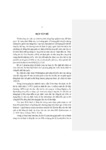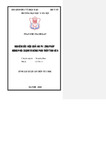
Please use this identifier to cite or link to this item:
http://dulieuso.hmu.edu.vn/handle/hmu/1970| Title: | Nghiên cứu hiệu quả hai phương pháp đông phôi chậm và đông phôi thủy tinh hóa |
| Authors: | Phan Thị Thanh, Lan |
| Advisor: | GS.TS. Nguyễn Viết, Tiến |
| Keywords: | 62720131;Sản phụ khoa |
| Abstract: | Những kết luận mới của luận án:. Tỷ lệ phôi sống của nhóm ngày 2 cao hơn nhóm ngày 3, có ý nghĩa thống kê. Tỷ lệ phôi sống ở phương pháp thủy tinh hóa có xu hướng cao hơn phương pháp đông chậm. Hình thái phôi tốt có tương quan chặt về số lượng sau mỗi bước kỹ thuật và làm tăng khả năng có thai, có ý nghĩa thống kê. Trừ nhóm phôi ngày 3, ở phương pháp đông chậm, tăng không có ý nghĩa thống kê.Phôi trung bình và phôi xấu đều không tương quan sau mỗi bước kỹ thuật và không làm tăng khả năng có thai. Giá trị tiên lượng có thai của:. + Số phôi chuyển trong 1 chu kỳ là ≥ 3 phôi. + Độ dày niêm mạc tử cung là ≥ 8,05mm và <14,15mm.. + Điểm chuyển phôi là ≥ 4 điểm.. + Phôi tốt ngày 2, đông chậm: trước đông là ≥ 2 phôi, sau rã là ≥ 1 phôi, trước chuyển là ≥ 1 phôi.. + Phôi tốt ngày 2, thủy tinh hóa: trước đông là ≥ 1 phôi, sau rã là ≥ 1 phôi, trước chuyển là ≥ 1 phôi.. + Phôi tốt ngày 3, thủy tinh hóa: trước đông là ≥ 2 phôi, sau rã là ≥ 2 phôi, trước chuyển là ≥ 2 phôi.. Giá trị tiên lượng có thai cộng dồn 100% của:. + Phôi tốt ngày 2, đông chậm: trước đông là ≥ 15 phôi, sau rã là ≥ 9 phôi, trước chuyển là ≥ 5 phôi.. + Phôi tốt ngày 2, thủy tinh hóa: trước đông là ≥ 17 phôi.. + Phôi tốt ngày 3, thủy tinh hóa: trước đông là ≥ 11 phôi, trước chuyển là ≥ 5 phôi.. - Diễn tiến thai kỳ: tỷ lệ có thai, tỷ lệ thai ngừng tiến triển, tỷ lệ đẻ con sống của nhóm thủy tinh hóa có xu hướng cao hơn nhóm đông chậm. Tỷ lệ có thai, tỷ lệ đẻ con sống sau chuyển phôi trữ lạnh ngày 2 không khác biệt so với ngày 3.. - Cân nặng và chiều cao của trẻ sinh ra sau chuyển phôi trữ lạnh có xu hướng không khác biệt giữa 2 phương pháp đông lạnh chậm và thủy tinh hóa, không có sự khác biệt với trẻ sinh ra từ thụ thai tự nhiên.. - Đến 4 tuổi, tỷ lệ trẻ không có bệnh lý di truyền, dị tật bẩm sinh ở nhóm đông chậm là 100%, ở nhóm thủy tinh hóa là 94,2%. 5,8% trẻ ở nhóm thủy tinh hóa có bệnh lý di truyền, dị tật bẩm sinh. Cần phải nghiên cứu sâu hơn với cỡ mẫu lớn để có thể kết luận chính xác liệu có sự liên quan của phương pháp trữ lạnh với hiện tượng dị tật ở trẻ hay không? cũng như tiên lượng lâu dài sự phát triển thể chất, tâm vận động và bệnh tật của trẻ sinh ra sau chuyển phôi đông chậm và thủy tinh hóa.. New conclusions of the thesis:. - The rate of live embryos of day 2 group is higher than that of day 3 group (p<0,05), in the vitrification method tends to be higher than the slow, . - Good embryo morphology has a close correlation in quantity after each technical step and increases the probability of pregnancy, which is statistically significant. Except for the group of embryos on day 3, in the slow freezing method, the increase was not statistically significant. Average embryos and bad embryos are not correlated after each technical step and do not increase the chance of becoming pregnant.. Pregnancy prognostic value of:. + Number of embryos transferred in 1 cycle is ≥ 3 embryos. + The lining of the uterus is ≥ 8.05mm and <14.15mm.. + The embryo transfer point is ≥ 4 points.. + Embryos are good on day 2, slow freezed: before frozen is ≥ 2 embryos, after thawing is ≥ 1 embryos , before transfer is ≥ 1 embryos.. + Good embryo day 2, vitrification: before frozen is ≥ 1 embryos, after thawing is ≥ 1 embryos , before transfer is ≥ 1 embryos.. + Embryos good on day 3, vitrification: before frozen is ≥ 2 embryos, after thawing is ≥ 2 embryos , before transfer is ≥ 2 embryos.. The prognostic value of pregnancy accumulates 100% of:. + Embryos are good on day 2, slow freezed:before frozen is ≥ 15 embryos, after thawing is ≥ 9 embryos , before transfer is ≥ 5 embryos.. + Good embryo day 2, vitrification:before frozen is ≥ 17 embryos.. + Good embryo day 3, vitrification: before frozen is ≥ 11 embryos, before transfer is ≥ 5 embryos.. - Progression of pregnancy: clinical pregnancy rate, pregnancy rate stop progressing, live birth rate of vitrification group tends to be higher than that of slow-growing group.. - The weight and height of children born after cold embryo transfer tends to have no difference between slow and vitrification methods, there is no difference with babies born from natural conception.. - Up to 4 years old, The rate of children without genetic diseases, congenital malformations in the east group was 100%, in the vitrification group was 94.2%. 5.8% of children in vitreous group have genetic diseases, birth defects. Further research is required with a large sample size so that it can be concluded whether there is a link to the cold storage method with child malformations. as well as the long-term prognosis of physical development, movement mind and disease of children born after slow-frozen embryos and vitrification. |
| URI: | http://dulieuso.hmu.edu.vn//handle/hmu/1970 |
| Appears in Collections: | Luận án (nghiên cứu sinh) |
Files in This Item:
| File | Description | Size | Format | |
|---|---|---|---|---|
| 488_TVLA PHANTHILANANH.pdf Restricted Access | 2.74 MB | Adobe PDF |  Sign in to read | |
| 488_TTLA PhanThiLanAnh.pdf Restricted Access | 1.25 MB | Adobe PDF |  Sign in to read |
Items in DSpace are protected by copyright, with all rights reserved, unless otherwise indicated.